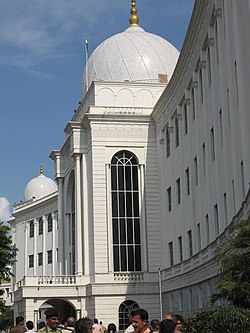Salar Jung Museum
From Wikipedia, the free encyclopedia
| Salarjung Museum | |
|---|---|
 | |
| Established | 1951 |
| Location | Nayapul, Hyderabad, Andhra Pradesh, India |
| Collection size | 1 million objects |
| Visitors | 11,24,776 as on March 2009[1] |
| Website | http://www.salarjungmuseum.in/ |
The Salar Jung Museum is an art museum located at Darushifa, on the southern bank of the Musi river in the city of Hyderabad,Andhra Pradesh, India. It is one of the three National Museums of India.[2] It has a collection of sculptures, paintings, carvings, textiles, manuscripts, ceramics, metallic artefacts, carpets, clocks, and furniture from Japan, China, Burma, Nepal, India, Persia, Egypt, Europe, and North America. The museum's collection was sourced from the property of the Salar Jung family.
Contents
[hide]History[edit]
The Salarjung Museum is the third largest museum in India housing the biggest one-man collections of antiques in the world. It is well known throughout India for its prized collections belonging to different civilizations dating back to the 1st century. Nawab Mir Yusuf Ali Khan Salar Jung III (1889–1949), former Prime Minister of the seventh Nizam of Hyderabad, spent a substantial amount of his income over thirty five years to make this priceless collection, his life's passion. The collections left behind in his ancestral palace, 'Diwan Deodi' were formerly exhibited there as a private museum which was inaugurated by Jawaharlal Nehru in 1951. Old timers believe that the present collection constitutes only half of the original art wealth collected by Salar Jung III. His employees siphoned off part of it, since Salar Jung was a bachelor and depended upon his staff to keep a vigil. Some more art pieces were lost or stolen during the shifting of the museum from Dewan Devdi to the present site.[3] Later in 1968, the museum shifted to its present location at Afzalgunj and is administered by a Board of Trustees with the Governor of Andhra Pradesh as ex officio chairperson under the Salar Jung Museum Act of 1961.
Collections[edit]
The Indian historical collections includes,[4]
- The paintings of legendary Raja Ravi Varma
- Aurangzeb's sword.
- Jade crafted daggers of, Emperor Jehangir, Noorjahan and Shah Jehan.
- A wardrobe of Tipu Sultan and
- A tiffin box made of gold and diamond
The furniture collection belonging from the time of Louis 14th-17th and Napoleon. Salar Jung III collected about 43,000 artifacts and 50,000 books and manuscripts out of which only few are displayed in today's museum.[5]
Galleries[edit]
The museum building in a semicircular shape with 38 galleries, spread on two floors, displays only a part of the original collections. The ground floor has 20 galleries and the first floor has 18 galleries. The exhibits on different subjects are displayed in separate galleries. Each gallery is huge and has many artefacts on display including ones dated back to the 17th century.
Apart from the galleries, there is a reference Library, reading room, publication and education section, chemical conservation lab, sales counter, cafeteria etc. Guides are available at fixed timings free of charge.[6]
Important Exhibits[edit]
There are Aurangzeb's daggers belonging to empress Noor Jehan, emperors Jehangir and Shah Jehan, the turbans and chair of Tippu Sultan, furniture from Egypt, paintings on display. Among the sculptures stands out the world famous statue of Veiled Rebecca by G.B. Benzoni, an Italian sculptor, in 1876. Her beautiful face hazily is visible through a marble but gossamer veil. Equally captivating is a double-figure wood sculpture. It stands before a mirror and shows the facade of a nonchalant Mephistopheles and the image of a demure Margaretta in the mirror. The eastern section is of equal importance with its wide variety of silk weaving and different art forms, including layer wood cutting paintings, porcelain works and many more, dating back to almost 2nd century.[7]
Quran Collections[edit]
The Museum has a famous Quran Collection from around the World in different fonts and designs. The Quran Written with Gold and Silver, There are many more collections of religious books,as well as Arabic Quran.[8]
The Clock[edit]
A bewildering variety and array of clocks greets the visitor in the clock room. There are ancient Sandiaers in the form of obelisks to huge and modern clocks of the twentieth century. Others in the range vary from miniature clocks which need a magnifying glass to imbibe their beauty and complexity to stately grandfather clocks from as far away as France, Germany, Italy, Switzerland and Britain. A visual delight is the musical clock Salar Jung bought from Cook and Kelvey of England. Every hour, a timekeeper emerges from the upper deck of the clock to strike a gong as many times as it is the hours of the day.[9]
The Indian Parliament has declared the museum an Institution of National Importance.
The museum is open from 10:00 to 17:00 (except on FriVeiled Rebecca of Salar Jung Museum

1 comment:
Uttarakhand is a hub of tourist places whole Uttarakhand is infused with tourist place like pilgrims tour ( Char Dham Yatra), Tourist place and hill station like Nainital Ranikhet and Corbett National Park which make it different from other state of India.
Post a Comment